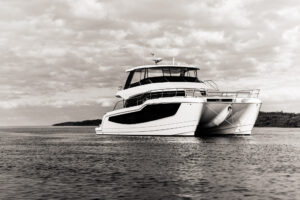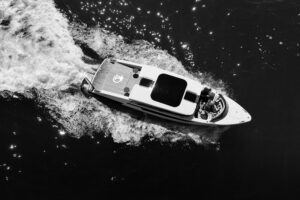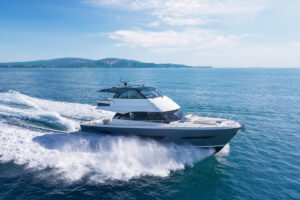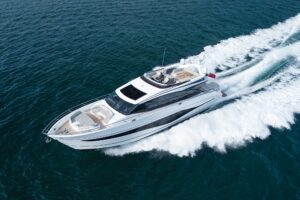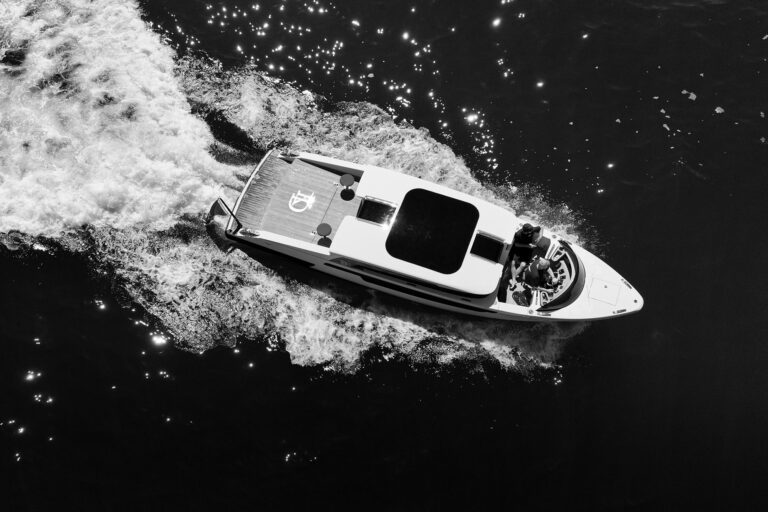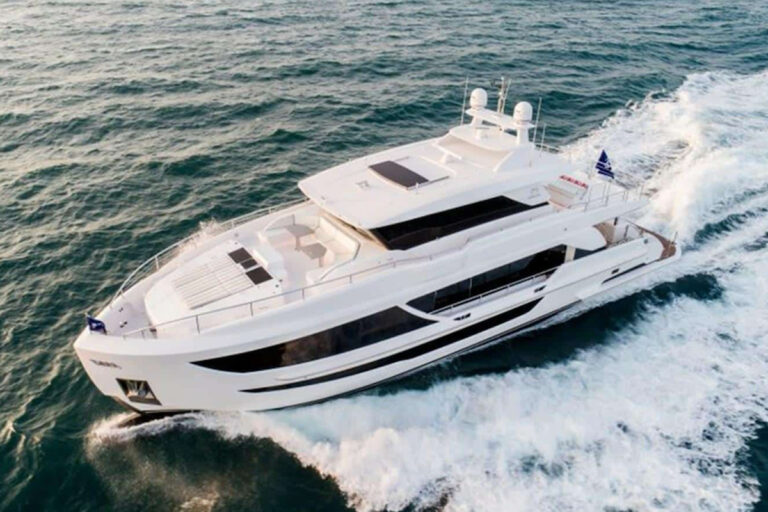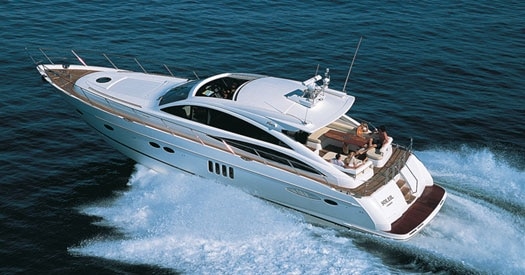
MAX HEADROOM: The 65’s sunroof retracts seamlessly, flooding the helm and saloon with light and air.
There is quite a fleet of European production yachts available in the United States these days, but only one that wears the nameplate of a mainstream American brand. When the relationship between Viking Yachts and Princess Yachts International of Plymouth, England, was launched 11 years ago, the goal was to offer American yachtsmen a European alternative that would feel somewhat familiar. The plan was to build stylish, high-performance yachts tailored to suit the U.S. market, minus the service and support complications that can sometimes arise with products built overseas.
Since the launch of the program, I have sea trialed a number of sport cruisers and each has seemed more refined than the last. Now the cross-pond pollination that has helped Viking’s Sport Cruisers program to flourish brings us the V65 yacht. This latest delivery to our shores is yet another example of why Viking Sport Cruisers are such a comfortable fit for performance- and style-conscious American yacht owners.
Although Great Britain is an island and generally considered by those of us here on the frontier to be a part of Europe, it is rather different-and so are the products it builds. Yet the 65 exudes Euro-style and could easily be mistaken for a chic Italian job. Her topsides have elliptical port lights and vents as well as a bank of windows-a domestic feature that has become standard fare on modern yachts. Her gentle reverse sheer is capped by a low, rakish superstructure and hardtop that sweeps aft around a brow-like window line. Large aggressive vents balance her silhouette. She is a strikingly good-looking design and is in no way overdone or busy. There was clearly a purpose to each stroke of her designer’s pen.
The 65 is one of four Viking express-style Sport Cruisers models, distinguished from the Sport Cruisers Fly Bridge Yacht and Motor Yacht lines by their indoor/outdoor main deck arrangements. The 65’s cockpit has U-shaped seating that faces a beautifully designed folding cherry table that is supported by a cleverly crafted stainless steel pedestal that is ideal for cocktails or dining alfresco. An adjacent sunpad area has storage within for dock lines and fenders. A wet bar is fitted with a refrigerator, an icemaker and a grill. Centerline steps lead aft to the swim platform and a transom garage suitable for a small tender. An articulated passerelle retracts to hide under the steps. Both passerelle and garage door are controlled by a keypad cleverly hidden in the stainless steel rail-very James Bond. While the standard teak cockpit sole seems a must, I would pass on the optional teak side decks as too much trouble to maintain.
A sliding stainless steel and glass door joins the cockpit area to the saloon/helm area. As seems the rage for this style boat, a section of the overhead retracts opening the bulk of the area to the sky. I’ll admit that it was rather nice speeding along off of Miami Beach on a brilliant sunny day with the sky above. I could imagine that it would be just as pleasant dockside on a starlit night. Credit is due the 65’s engineers, for this retractable roof system is by far the most refined I have encountered to date. Its motion is smooth and even as the roof integrates seamlessly with the overhead when closing.
A U-shaped seating area to starboard has a large glass table suited for formal dining. There is also a U-shaped dinette area adjacent to the helm. This seems a bit redundant and those less interested in entertaining might want to opt for a smaller cocktail table instead of the dining table. A 32-inch flat-panel TV rises on a lift and is hidden in the joinery behind a settee port.
A stair leads below to a small well-organized galley area with a refrigerator/freezer, a cooktop, a dishwasher and a microwave convection oven. A passageway leads forward to a VIP stateroom with a queen island berth and a private head. A second guest stateroom has upper and lower berths and private access to the day head. The passageway leads aft of the galley to a full-beam master stateroom with a queen-size berth and a private head. The hull-side windows add light and ventilation. Interior fit and finish is excellent and seems well above typical production standards. This effect is in part due to the British obsession with detail and efficiency-my guess is that every little thing was fully explored on paper prior to production. The thoughtful result of this approach is complemented by brilliant stainless steel work and high-end hardware, fixtures and accessories. High-gloss cherry joinerwork and the hardwood soles in the saloon and galley area are standard. A Euro-style (i.e., very small) crew cabin is accessible from the cockpit and has a single berth and a head. It might be useful for stashing cruising supplies or kids.
The 65’s machinery space is accessible from the crew compartment. While there is room to move about on centerline, wing tanks make access outboard of the optional 12-cylinder MANs rather tight. Service points appear accessible and the generous headroom makes it possible to reach over the engines. Viking’s Sport Cruisers are designed specifically for the American market so 60-cycle electrical service is standard and most mechanical components and appliances are familiar brands. Any components used in the 65’s construction or outfitting that are not readily available in the United States are stocked at Viking’s service facilities in South Florida and New Jersey. The 65’s hull bottom is a solid fiberglass laminate supported by a network of fiberglass stringers and web frames. Closed-cell foam is used to stiffen the hull sides, decks and superstructure. While many European builders rely on subcontractors, virtually everything on the 65, including metal work, wiring and joinerwork, is done in-house. In my experience this typically yields a more consistent, higher quality result.
I have saved the best for last: The 65’s performance is notable. As I perched in her sportscar-like helm, I compared her precise high-speed cornering and finger-on-the-wheel tracking with her four-wheeled cousins ashore. (Something I have found typical of Bernard Olesinski’s designs.)
With two-thirds of a tank of fuel, she reached a maximum speed of 38.2 knots at 2350 rpm; and at 2100 rpm, a speed of 34.2 knots and a fuel burn of 110 gallons per hour. Viking suggests a range of about 300 nautical miles at this throttle setting, which our numbers suggest is reasonable. While sea conditions during our testing provided little challenge, my sense is that the 65’s relatively fine entry and 21-degree transom deadrise will deliver a dry, comfortable ride in tougher going.
Our test boat priced out at $3,015,145 with the 1,360 hp MANs, a solid electronics package and a list of options that included everything from linens to underwater lights. This is a premium price, but those who buy sport cruisers are buying peace of mind as well as a stylish European ride. That’s why, if you have a taste for European design but have never considered investing in a foreign brand, the Viking Sport Cruisers line is worth consideration. Certainly if you love boats and performance no matter the stripe or land of origin, you will like this 65.
Contact: Viking Sport Cruisers, (609) 296-6000; www.vikingsportcruisers.com

